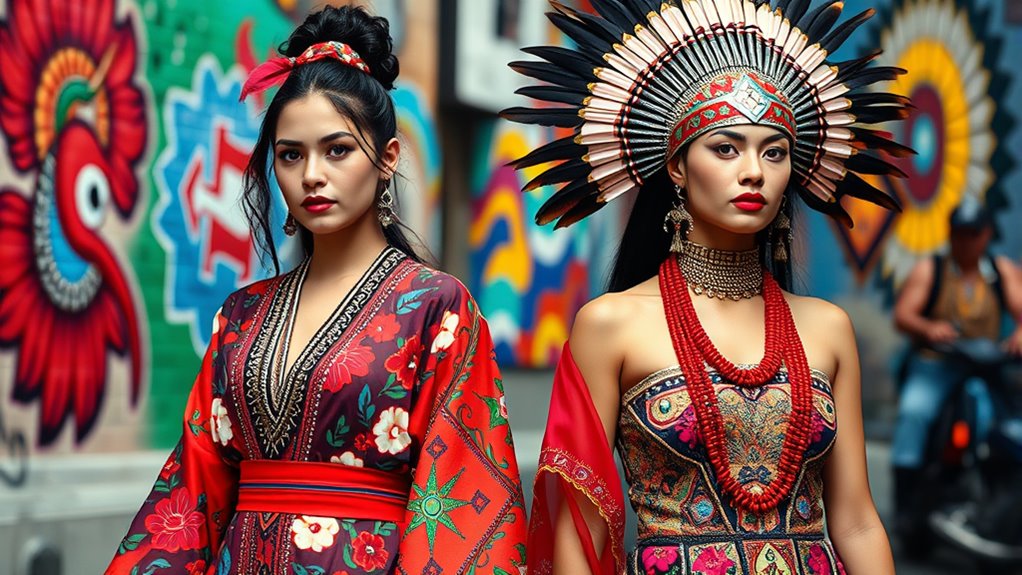Understanding the difference between cultural appropriation and appreciation in fashion is key to respecting diverse traditions. Appropriation involves using cultural elements without understanding or respect, often leading to stereotypes or offense. Appreciation, on the other hand, celebrates and learns about the significance of cultural styles while supporting authentic sources. By approaching fashion with awareness and sensitivity, you honor communities and prevent unintentional harm. Keep exploring to discover how to make your fashion choices respectful and meaningful.
Key Takeaways
- Cultural appreciation involves respectful learning and acknowledgment of a community’s traditions, while appropriation often exploits or trivializes them.
- Wearing traditional styles with understanding and consent honors their cultural significance; appropriating ignores context and meaning.
- Appreciation supports authentic artisans and communities, whereas appropriation can lead to exploitation and cultural misrepresentation.
- Recognizing sacred or reserved elements prevents trivializing or disrespecting the cultural symbols involved.
- Responsible fashion choices foster genuine respect, preserve cultural integrity, and promote meaningful cross-cultural understanding.

Cultural exchange can be enriching, but it often blurs the line between appreciation and appropriation. When you explore different cultures through fashion, it’s easy to get caught up in the excitement of discovering bold patterns, unique accessories, and traditional styles. However, without careful awareness, your enthusiasm might unintentionally cross into cultural insensitivity. That’s where fashion sensitivity comes into play. Being sensitive to the origins and significance of cultural elements helps you respect the communities behind these styles, ensuring your admiration doesn’t turn into appropriation. It’s essential to recognize that wearing traditional garments or symbols isn’t just about aesthetics; they often carry deep historical, spiritual, or social meanings. If you don’t understand their significance, you risk reducing these meaningful elements to mere fashion statements, which can be hurtful or disrespectful.
To navigate this, you should approach cultural exchange with curiosity and humility. Educate yourself about the history and significance of the styles or items you’re interested in. For example, before wearing a kimono, learn about its cultural roots and the occasions it’s meant for. Similarly, if you’re drawn to Indigenous patterns or jewelry, understand their importance within those communities. This approach demonstrates respect and shows that your interest is genuine rather than superficial. It’s also crucial to avoid stereotypes or caricatures that can perpetuate harmful misconceptions. Instead, opt for authentic sources—like collaborating with designers from the culture or purchasing directly from artisans—so that your fashion choices support and uplift the communities involved.
Additionally, practicing cultural awareness helps prevent unintentional disrespect and fosters meaningful connections with the communities behind the styles. Fashion sensitivity also involves understanding the context in which you wear certain items. Wearing a traditional outfit to a cultural festival might be appropriate if done respectfully and with permission. But don’t wear it casually or as a costume, which trivializes the cultural significance. Recognize that some styles may be sacred or reserved for specific members of the community, and appropriating them can cause offense. The goal is to celebrate diversity without appropriating it. When you approach cultural exchange thoughtfully, you foster respect rather than exploitation, and you help build bridges of understanding rather than walls of misunderstanding.
In essence, being mindful of your fashion sensitivity means embracing cultural exchange as an opportunity to learn and honor, rather than to appropriate. By doing so, you ensure that your appreciation is genuine and respectful, helping to preserve the dignity and integrity of the cultures you admire. Your awareness and sensitivity can make a difference, transforming your fashion choices into acts of respect and celebration rather than insensitivity.
Frequently Asked Questions
How Can Brands Respectfully Incorporate Cultural Elements Into Fashion?
When you want to incorporate cultural elements into fashion, focus on respectful design through cultural collaboration. Engage with communities to understand the significance of their traditions, ensuring your inspiration is authentic. Always seek permission and credit their contributions. By working directly with cultural representatives, you create a respectful, meaningful collection that honors their heritage, rather than appropriating it. This approach fosters mutual respect and enriches your brand’s authenticity.
What Are Signs That a Fashion Trend Is Cultural Appropriation?
Did you know that 60% of people believe cultural missteps in fashion harm communities? When you see trends that ignore cultural boundaries, it’s a sign of cultural appropriation. Signs include using symbols without understanding their meaning, trivializing sacred items, or profiting without respect. If the trend lacks respectful symbolism and disrespects cultural context, it’s likely appropriation rather than appreciation. Always consider the cultural significance behind the elements you incorporate.
How Does Cultural Appreciation Impact Minority Communities?
When you appreciate another culture, you support cultural identity and foster community empowerment. Your respectful recognition can help minority communities feel seen and valued, strengthening their pride and traditions. By highlighting their unique styles thoughtfully, you contribute positively, ensuring their heritage isn’t erased or misrepresented. This genuine appreciation builds bridges, promotes understanding, and uplifts communities rather than exploiting their culture for fashion trends.
Can Cultural Exchange in Fashion Be Considered Respectful?
You might think cultural exchange in fashion is harmless, but it’s a delicate dance that can make or break respect. When you honor cultural boundaries and stay within ethical boundaries, your actions show genuine respect. But crossing those lines risks deep offense and cultural insensitivity. So, yes, cultural exchange can be respectful if you’re mindful, don’t exploit traditions, and truly appreciate the history behind the styles you embrace.
What Role Does Consumer Awareness Play in Preventing Cultural Insensitivity?
You play a key role in preventing cultural insensitivity by staying aware of cultural sensitivity issues. As an ethical consumer, your choices influence brands to promote respectful representation and avoid harmful stereotypes. When you educate yourself about the origins and significance of cultural elements, you support respectful cultural exchange. Your awareness encourages fashion brands to prioritize ethical practices, fostering a more inclusive industry that values genuine appreciation over superficial appropriation.
Conclusion
By understanding the line between appreciation and appropriation, you become more mindful of your choices. You honor cultures by respecting their origins, embracing their beauty, and acknowledging their significance. You avoid exploitation by questioning your intentions, recognizing the impact, and listening to marginalized voices. Ultimately, you choose awareness over ignorance, respect over disrespect, and genuine connection over superficial trends. In doing so, you foster appreciation, nurture understanding, and promote a more inclusive, respectful fashion world.









